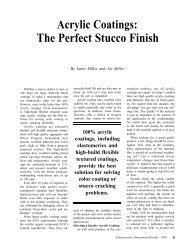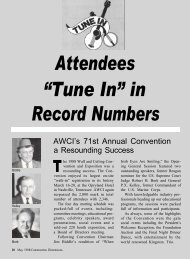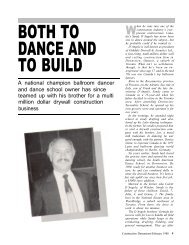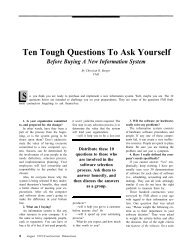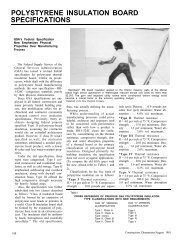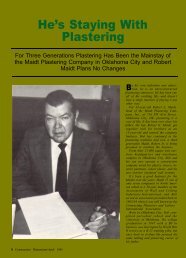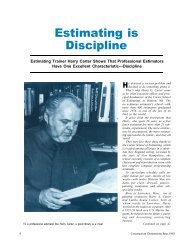Transmission Loss: Drywall Partitions - AWCI
Transmission Loss: Drywall Partitions - AWCI
Transmission Loss: Drywall Partitions - AWCI
Create successful ePaper yourself
Turn your PDF publications into a flip-book with our unique Google optimized e-Paper software.
<strong>Transmission</strong> <strong>Loss</strong>:<br />
<strong>Drywall</strong> <strong>Partitions</strong><br />
The facts about steel vs. wood studs;<br />
does sound absorption batts help; effect<br />
of increasing the thickness of gypsum board.<br />
By Michael J. Kodaras<br />
Acoustical Consultant<br />
<strong>Drywall</strong> construction has made transmission loss can be helpful to<br />
such inroads that today there is a contractor in many ways.<br />
rarely a new building that does not This article provides such inforcontain<br />
gypsum board. In single mation as derived from a series of<br />
and multi-family dwellings, scho- 90 transmission loss tests conductols,<br />
stores, office buildings, archi- ed at the National Research Countects<br />
and owners have found dry- cil in Canada and published as<br />
wall partitions acceptable even Building Research Note No. 66 by<br />
though the requirements for Dr. T. D. Northwood of N.R.C.<br />
acoustical separation, in some The basic drywall partition concases,<br />
have been as high as STC 55 sists of studs, either wood or light<br />
or even STC 60.<br />
gauge steel channels, with gypsum<br />
Some knowledge of what im- board on each side secured to the<br />
proves drywall construction sound studs by nails, self-tapping screws<br />
or adhesive. The studs are held in<br />
place at top and bottom by wood<br />
plates or steel channels.<br />
Conventionally, the wood studs<br />
are 1-5/8" by 3-5/8" in dimension,<br />
spaced 16" or 24" on center. Steel<br />
studs are 2-1/2" or 3-5/8" in depth<br />
and are usually spaced on 24" centers.<br />
The space between the studs<br />
may be filled with rockwool or<br />
glass fiber batts varying in thickness<br />
from 1/2" to 3".<br />
Joints are finished with tape and<br />
a joint compound to provide a<br />
smooth, joint-free appearance.<br />
Tight seals at the entire periphery<br />
are essential and are usually<br />
achieved by means of one or more<br />
caulking beads.<br />
When a very high degree of<br />
acoustical separation is desired or<br />
specified, a second layer can be<br />
laminated to one or both sides of<br />
the partition using joint compound<br />
applied with a special applicator in<br />
strips 5/6" wide by 5/8" thick,<br />
spaced about 2" apart.<br />
Results Are Tested<br />
Obviously all of these application<br />
details were not arrived at haphazardly—they<br />
all result from a<br />
great deal of research, tests and<br />
experiments and legitimate questions<br />
can be asked as to the reasons<br />
for these procedures and what will<br />
happen when changes are made.<br />
Before proceeding with these<br />
questions, however, it should be<br />
noted that sound transmission loss<br />
tests of drywall partitions are<br />
made in a uniform manner by laboratories<br />
in the U.S. and Canada in<br />
accordance with ASTM E90,<br />
“Laboratory Measurement of Airborne<br />
Sound <strong>Transmission</strong> <strong>Loss</strong> of<br />
Building <strong>Partitions</strong>”. The test data<br />
used in this article were conducted<br />
under either the 1966 or 1971 versions<br />
of this standard.<br />
Although transmission loss tests<br />
are conducted at 16 frequencies<br />
over a range of 125 to 4000 hertz, it<br />
is usual to use a single number<br />
(STC) derived from the test data in<br />
accordance with another ASTM<br />
Standard, E413-70T, “Determination<br />
of Sound <strong>Transmission</strong> Class”.<br />
Q: Are steel studs better than<br />
wood studs?<br />
A: Studs play an important part in<br />
the transmission loss of drywall<br />
Continued on page 52<br />
22
TRANSMISSION LOSS<br />
Continued from page 22<br />
partitions. Since lightweight<br />
steel channel studs are less<br />
rigid than wood studs, they<br />
transmit much less acoustical<br />
energy from the gypsum board<br />
on one side to the gypsum<br />
board on the other side of the<br />
stud.<br />
2 x 4 wood studs 24" o.c., 1/2"<br />
gypsum board two sides =<br />
STC 35<br />
3-5/8" steel studs 24" o.c., 1/2"<br />
gypsum board two sides =<br />
STC 37<br />
2 x 4 wood studs 24" o.c., 5/D8"<br />
gypsum board two sides =<br />
STC 36<br />
3-5/8" steel studs 24" o.c., 5/8"<br />
gypsum board two sides =<br />
STC 39<br />
Q: Will rockwool or fiberglass insulation<br />
improve the transmission<br />
loss of drywall partitions?<br />
A: The installation of sound absorption<br />
materials between the<br />
studs definitely improves the<br />
transmission loss performance.<br />
52<br />
Because, of the springy flexibility<br />
of the steel stud, the improvement<br />
is greater with the<br />
steel stud than with wood studs.<br />
Tests conducted of 2 x 4 wood<br />
studs and 3-5/8" steel stud<br />
partitions, both spaced 24" on<br />
center, with and without 2"<br />
sound absorption material,<br />
showed the following results:<br />
2 x 4 studs with 1/2" gypsum<br />
board, no insulation = STC 35<br />
2 x 4 studs, 1/2" gypsum board<br />
with 2" insulation = STC 40<br />
Improvement = 5 STC<br />
3-5/D8" steel studs with 1/2"<br />
gypsum board, no insulation =<br />
STC 37<br />
3-5/8" steel studs, 1/D2"<br />
gypsum board with 2" insulation<br />
= STC 46<br />
Improvement = 9 STC<br />
Q: Is the thickness of the insulation<br />
an important factor?<br />
A: Insulation thickness is not very<br />
critical, however, a minimum of<br />
2" thickness is recommended.<br />
Q: What improvement can be expected<br />
from using 5/8" thick instead<br />
of 1/2” thick gypsum<br />
board?<br />
A: Substituting 5/D8" thick for<br />
1/2" thick gypsum board increases<br />
the mass or weight of<br />
the partition and thus increases<br />
the transmission loss. The improvement<br />
varies between 1<br />
and 2 STC independent on<br />
whether wood or steel studs are<br />
used or whether sound absorption<br />
is present between the<br />
studs.<br />
Q: How important is the taping<br />
and joint compound procedure<br />
at the joints?<br />
A: The labor consuming application<br />
of tape and joint compound<br />
at gypsum board joints is required<br />
primarily for cosmetic<br />
reasons. Assuming that the<br />
gypsum board joints are not<br />
open, the same transmission<br />
loss results can be achieved by<br />
applying masking tape to the<br />
joints.<br />
Q: How important is caulking?<br />
A: Caulking is a must! It is essential<br />
that one or more beads of<br />
caulking be applied to seal the<br />
space between the edge of the<br />
gypsum board and the floor, ad-
jacent walls and the ceiling.<br />
Applying the caulking beads<br />
between the floor, wall and ceiling<br />
channels and the connecting<br />
surface will be satisfactory providing<br />
the gypsum board covers<br />
the channel flange. Plastic or<br />
wood base should not be depended<br />
upon to seal the space<br />
between the bottom of the gypsum<br />
board and the channel<br />
flange. Also, use the non-hardening<br />
types of caulking recommended<br />
for acoustical sealing of<br />
drywall constructions.<br />
Q: Is Type X (fire resistant) gypsum<br />
board better than standard<br />
gypsum board?<br />
A: The tests conducted at N.R.C.<br />
indicated no difference in acoustical<br />
performance between the<br />
same thickness of conventional<br />
gypsum board and Type X<br />
board. This was also the case<br />
for vinyl covered board of the<br />
same thickness.<br />
Q: How much improvement can be<br />
expected by laminating two<br />
layers of gypsum board?<br />
A: While adding mass to a partition<br />
by laminating double layers<br />
of gypsum board to one or both<br />
sides theoretically should improve<br />
the performance, it is a<br />
trend of diminishing returns.<br />
One additional layer on one side<br />
is quite beneficial, however, the<br />
second layer on the other side<br />
seems to add little or nothing to<br />
the acoustical performance.<br />
2 x 4 studs, no absorption, 1/2"<br />
gypsum board each side =<br />
STC 33<br />
Same construction, after adding<br />
1 additional layer on one side<br />
only = STC 37<br />
Same construction, after adding<br />
an additional layer on both<br />
sides = STC 37<br />
3-5/8" steel studs, 2" sound absorption,<br />
1 layer 1/2" gypsum<br />
board each side = STC 46<br />
Same construction, after adding<br />
1 additional layer on one side<br />
only = STC 50<br />
Same construction, after adding<br />
an additional layer on both<br />
sides = STC 51<br />
Q: How about flanking paths?<br />
A: The flanking of sound around<br />
the partition is always a problem<br />
and a discussion of flanking<br />
paths and how to detect them vided by a well constructed<br />
was included in Vol. 1, No. 1, drywall partition.<br />
December 1974 issue of Con- In summary, worthwhile improvestruction<br />
Dimensions in an ments can be obtained by installing<br />
article entitled, “Partition Com- a drywall partition with steel studs<br />
plaints”. It should be emphasiz- instead of wood studs and by ined<br />
that unless special precau- stalling 2" sound absorption<br />
tions are taken in wood joist material between the studs. 5/8"<br />
and truss floor construction, gypsum board will also provide<br />
the flanking path through the better results than 1/2" gypsum<br />
gypsum board ceiling, over the board and caulking is all important<br />
top of the partition and down and must be done properly without<br />
through the ceiling on the other gaps. Laminate another layer of<br />
side can substantially reduce gypsum board on one side for even<br />
the acoustical separation pro- greater transmission loss.




